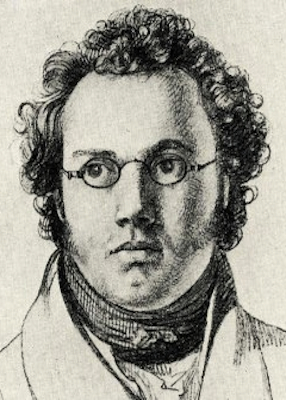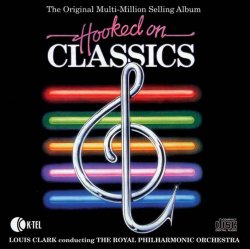
The Trout Quintet (Forellenquintett) is the popular name for the Piano Quintet in A major, D. 667, by Franz Schubert. The piano quintet was composed in 1819, when he was 22 years old; it was not published, however, until 1829, a year after his death.
The Piano Quintet in F minor, Op. 34, by Johannes Brahms was completed during the summer of 1864 and published in 1865. It was dedicated to Her Royal Highness Princess Anna of Hesse. As with most piano quintets composed after Robert Schumann's Piano Quintet (1842), it is written for piano and string quartet.
Cyclic form is a technique of musical construction, involving multiple sections or movements, in which a theme, melody, or thematic material occurs in more than one movement as a unifying device. Sometimes a theme may occur at the beginning and end ; other times a theme occurs in a different guise in every part.

Franz Schubert's final chamber work, the String Quintet in C major is sometimes called the "Cello Quintet" because it is scored for a standard string quartet plus an extra cello instead of the extra viola which is more usual in conventional string quintets. It was composed in 1828 and completed just two months before the composer's death. The first public performance of the piece did not occur until 1850, and publication occurred three years later in 1853. Schubert's only full-fledged string quintet, it has been praised as "sublime" or "extraordinary" and as possessing "bottomless pathos," and is generally regarded as Schubert's finest chamber work as well as one of the greatest compositions in all chamber music.

The Piano Sonata No. 18 in E♭ major, Op. 31, No. 3, is an 1802 sonata for solo piano by Ludwig van Beethoven. A third party gave the piece the nickname "The Hunt" due to one of its themes' resemblance to a horn call. Beethoven maintains a playful jocularity throughout much of the piece, but as in many of his early works, the jocular style can be heard as a facade, concealing profound ideas and depths of emotion.
Franz Liszt wrote drafts for his Concerto for Piano and Orchestra No. 2 in A major, S.125, during his virtuoso period, in 1839 to 1840. He then put away the manuscript for a decade. When he returned to the concerto, he revised and scrutinized it repeatedly. The fourth and final period of revision ended in 1861. Liszt dedicated the work to his student Hans von Bronsart, who gave the first performance, with Liszt conducting, in Weimar on January 7, 1857.
The six String Quartets, Op. 76, by Joseph Haydn were composed in 1797 or 1798 and dedicated to the Hungarian count Joseph Georg von Erdődy (1754–1824). They form the last complete set of string quartets that Haydn composed. At the time of the commission, Haydn was employed at the court of Prince Nicolaus Esterházy II and was composing the oratorio The Creation as well as Princess Maria Hermenegild Esterházy's annual mass.
The Piano Sonata No. 1 in F minor, Op. 6, by Alexander Scriabin, was the third of twelve piano sonatas that he composed. It was completed in 1892. The music is emotionally charged as much of the music was written after Scriabin had damaged his right hand through excessive piano playing.

The Sonata on the 94th Psalm in C minor is a sonata for solo organ by Julius Reubke, based on the text of Psalm 94. It is considered one of the pinnacles of the Romantic repertoire.

The Piano Sonata No. 1 in C major, Op. 1, of Johannes Brahms was written in Hamburg in 1853, and published later that year. Despite being his first published work, he had actually composed his Piano Sonata No. 2 first, but chose this work to be his first published opus because he felt that it was of higher quality. The piece was sent along with his second sonata to Breitkopf & Härtel with a letter of recommendation from Robert Schumann. Schumann had already praised Brahms enthusiastically, and the sonata shows signs of an effort to impress in its symphonic grandeur, technical demands, and dramatic character. It was dedicated to Joseph Joachim.
The Piano Sonata No. 2 in F♯ minor, Op. 2 of Johannes Brahms was written in Hamburg, Germany in 1852, and published the year after. Despite being his second published work, it was actually composed before his Piano Sonata No. 1 in C major, but was published later because Brahms recognized the importance of an inaugural publication and felt that the C major sonata was of higher quality. It was sent along with his first sonata to Breitkopf und Härtel with a letter of recommendation from Robert Schumann. Schumann had already praised Brahms enthusiastically, and the sonata shows signs of an effort to impress, with its technical demands and highly dramatic nature. It was dedicated to Clara Schumann.

The Fantasia in F minor by Franz Schubert, D.940, for piano four hands, is one of Schubert's most important works for more than one pianist and one of his most important piano works altogether. He composed it in 1828, the last year of his life. A dedication to his former pupil Caroline Esterházy can only be found in the posthumous first edition, not in Schubert's autograph.

The Piano Trio No. 1 in B major, Op. 8, by Johannes Brahms was completed in January 1854, when the composer was only twenty years old, published in November 1854 and premiered on 13 October 1855 in Danzig. It has often been mistakenly claimed that the first performance had taken place in the United States. Brahms produced a revised version of the work in summer 1889 that shows significant alterations so that it may even be regarded as a distinct (fourth) piano trio. This "New Edition", as he called it, was premiered on 10 January 1890 in Budapest and published in February 1891.

Christian Ludwig Schuncke was a German pianist and composer, and close friend of Robert Schumann. His early promise was eclipsed by his death from tuberculosis at the age of 23.
Sonatas, duos and fantasies by Franz Schubert include all works for solo piano by Franz Schubert, except separate dances. They also include a number of works for two players: piano four hands, or piano and a string instrument.

Hooked on Classics is a classical crossover album recorded by the Royal Philharmonic Orchestra conducted by Louis Clark, released in 1981 by K-tel and distributed by RCA Records, part of the Hooked on Classics series. It was produced by Jeff Jarratt and Don Reedman.
From March 1816 to August 1817, Franz Schubert composed four violin sonatas. All four were published after the composer's death: the first three, D 384, 385 and 408, as Sonatinas in 1836, and the last one, D 574, as Duo in 1851. Schubert composed two more pieces for violin and piano, in October 1826 and December 1827 respectively: a Rondo, D 895, which was published during the composer's lifetime (Op. 70), and a Fantasy, D 934, which was premiered in January 1828, less than a year before the composer's death.
Franz Schubert composed his Fantasy in C major for violin and piano, Op. posth. 159, D 934, in December 1827. It was the last of his compositions for violin and piano, and was premiered in January 1828 by the violinist Josef Slavik and the pianist Carl Maria von Bocklet at the Landhaussaal in Vienna.







